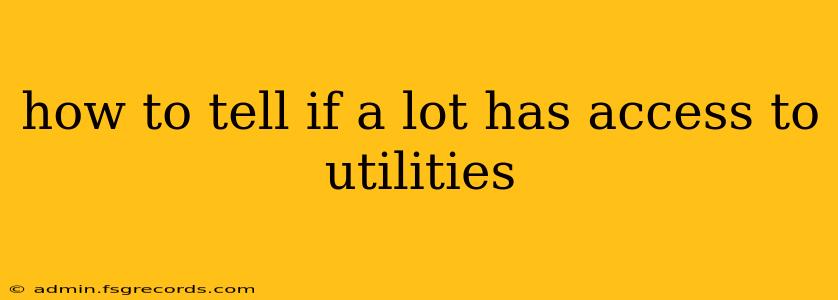Buying a lot, whether for building a home or other purposes, requires careful due diligence. One crucial aspect often overlooked is verifying access to essential utilities. This guide will walk you through various methods to determine if a lot has access to water, sewer, electricity, gas, and internet. Failing to confirm utility availability could lead to significant delays and unexpected costs during the construction or development phase.
Understanding Utility Access
Before diving into the methods, it's important to understand what "access" means. It doesn't just mean the utility lines are nearby; it means a legal and practical connection is possible, often involving easements, permits, and potentially connection fees.
Methods to Determine Utility Access
Here's a breakdown of how to determine if utilities are available for a specific lot:
1. Check Local Municipality Websites
Most municipalities have online resources providing property information, including utility availability maps or databases. Look for:
- GIS Mapping: Geographic Information Systems (GIS) maps often show the locations of utility lines and easements.
- Parcel Information: Your lot's parcel information, accessed through the assessor's office website, might indicate existing utility connections or planned infrastructure.
- Development Plans: Review any approved development plans for the area. These might detail utility infrastructure improvements.
2. Contact Utility Providers Directly
Don't rely solely on online resources. Contacting the utility companies directly is crucial:
- Water and Sewer: Contact your local water and sewer department. They can confirm service availability at the specific address or lot number. Ask about connection fees and any required permits.
- Electricity: Contact the electricity provider serving the area. They can verify whether the lot is within their service area and whether the necessary infrastructure is in place. Inquire about connection costs and timelines.
- Natural Gas (if applicable): Contact the natural gas company. Similar to electricity, they can confirm service area and connection details.
- Internet Providers: Reach out to several internet service providers (ISPs) to determine availability at the lot's location. Availability varies significantly depending on location and technology.
3. Review the Lot's Legal Documents
Review all available legal documents for the lot, including:
- Deed: The deed should specify any existing easements that grant access to utilities.
- Survey: A recent survey will visually show the location of any utility lines on or near the property.
- Title Report: A title report should highlight any potential issues related to utility access.
4. Hire a Professional Surveyor
If you're unsure or the information you gather is inconclusive, hiring a professional surveyor is highly recommended. A surveyor can:
- Locate Existing Utilities: They can accurately pinpoint the location of underground utility lines to avoid damage during construction.
- Verify Easements: They can verify the existence and legal status of any utility easements.
- Assess Feasibility: They can assess the feasibility of connecting utilities to the lot.
5. Consult with a Real Estate Agent or Developer
Experienced real estate agents and developers are familiar with local regulations and utility infrastructure. They can offer valuable insights and potentially save you time and effort.
Potential Complications and Considerations
- Utility Extensions: If utilities aren't readily available, you might need to pay for extensions, significantly increasing project costs.
- Easement Issues: Disputes over easements can cause delays and legal complications.
- Zoning Regulations: Zoning regulations might restrict certain types of utility connections.
By diligently employing these methods, you can significantly reduce the risk of unexpected utility-related problems when purchasing a lot. Remember, thorough investigation is crucial for a smooth and successful project.

